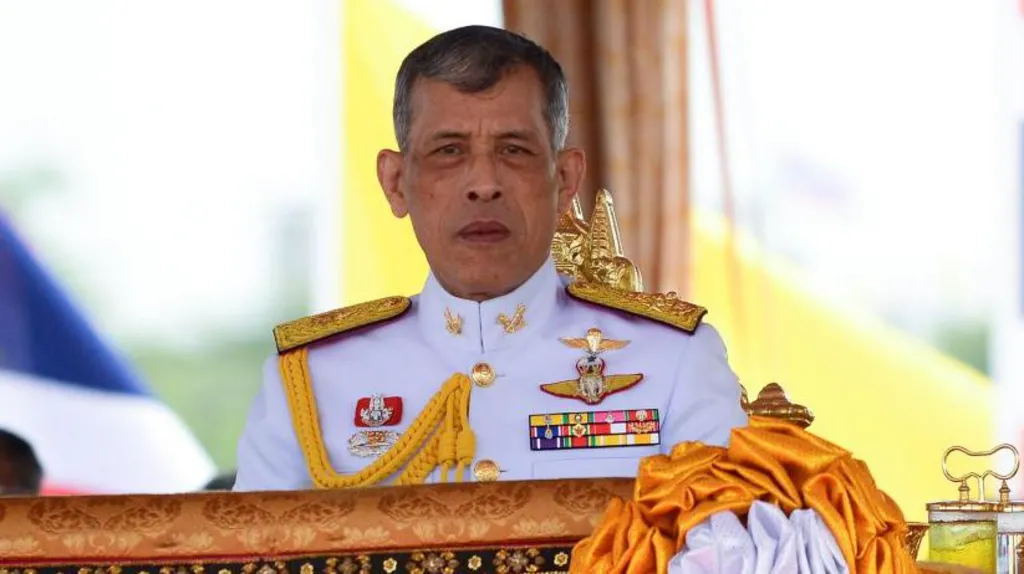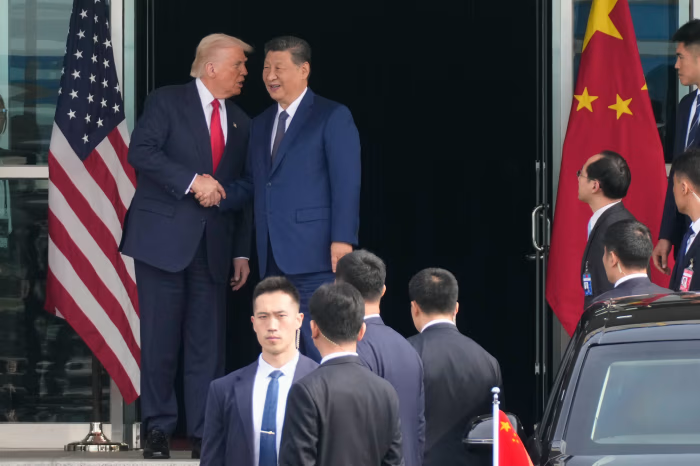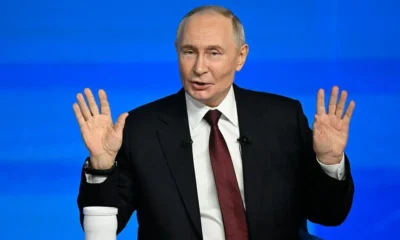China
China Turned Table Against Trump

Paris (Imran Y. CHOUDHRY) :- Former Press Secretary to the President, Former Press Minister to the Embassy of Pakistan to France, Former MD, SRBC Mr. Qamar Bashir analysis : Donald Trump’s return to aggressive protectionism—through sweeping tariffs on allies and rivals alike—has ignited what can only be described as a global trade war, or more aptly, a form of “tariff terrorism.” Cloaked in the rhetoric of “America First,” these economic policies were touted as the tools that would restore American greatness. Instead, they have exposed the diminishing grip of U.S. hegemony and accelerated the emergence of a multipolar world where unilateralism no longer commands submission.
China’s response to Trump’s tariffs is equally telling. Initially targeted with punitive duties reaching 145% on certain goods, Beijing did not fold. Instead, it recalibrated. By diversifying its trade relationships and reducing reliance on the U.S. market—now only accounting for 12% of China’s total exports—China insulated itself from American economic warfare. State propaganda turned Trump into a laughingstock, nicknaming him “Tariff Grandpa” and mocking U.S. inflation, while Chinese consumers embraced patriotic boycotts and switched from iPhones to Huawei.
More importantly, China didn’t come begging. Instead, it issued its own ultimatum: all tariffs must be removed, ab initio, or there will be no negotiations. Trump’s boast that President Xi would come “running on his knees” proved a fantasy. The tables have turned. Today, Trump’s team is the one chasing a deal while China plays hardball with its own set of strategic levers—like restricting rare earth exports vital to U.S. tech and defense.
Trump’s tariff strategy was initially framed as a corrective measure against trade deficits and so-called unfair practices, especially targeting China. But soon, the net widened to include America’s closest allies—Canada, Mexico, and the European Union. Steel and aluminum tariffs on Canada, for example, struck at the heart of a nation that sends 75% of its exports to the U.S., risking over 2.5 million jobs and nearly 20% of its GDP. To many Canadians, this was akin to a trusted firefighter torching their home and then demanding they hand over the deed for the promise of rebuilding.
Canada, once America’s most dependable partner, struck back with retaliatory tariffs on $155 billion worth of U.S. goods—from coffee and cars to ketchup and orange juice. Simultaneously, consumer prices in the U.S. rose due to higher import costs, pushing inflation up and GDP growth down. According to independent economic analyses, Trump’s tariffs contributed to a nearly 3% hit on U.S. GDP and stoked a persistent inflationary trend. The Yale Budget Lab estimated that his blanket tariff regime lifted the effective U.S. tariff rate to its highest level since 1943—an astounding shift in a matter of months.
Yet, Trump insists these measures are about reciprocity. “Other nations have taken advantage of us,” he says. But what is rarely acknowledged is that the U.S. has enjoyed an 80-year advantage since it established the dollar as the world’s reserve currency post-WWII. That singular privilege has allowed it to run deficits others could not afford. Trump’s zero-sum worldview ignores this history, bulldozing through nuanced economic relationships in favor of brute-force diplomacy.
What he and his acolytes misunderstand is that trust—not fear—is the bedrock of global trade. When the U.S. unilaterally imposes tariffs on allies and tears up treaties like the USMCA, it shatters that trust. Trump has turned America’s traditional leadership role into a transactional, coercive enterprise. As a result, even America’s friends are turning elsewhere. In 2024, China overtook the U.S. in trade volume with the European Union—€856 billion versus €822 billion—a symbolic but significant shift in global allegiances.
Meanwhile, Europe, another target of Trump’s scorn, has closed ranks. His attacks on NATO, his support for authoritarian-leaning figures like Viktor Orbán, and his lecturing of EU leaders by political novices like JD Vance have unified the continent in resistance. They are no longer willing to accept the U.S. as the sole arbiter of global order. What Trump saw as leverage turned into alienation. A once-cohesive transatlantic alliance now navigates its future with less dependence on Washington.
This unraveling of global goodwill is compounded by economic damage at home. Tariffs don’t make America stronger—they hurt American families and businesses. One importer, who once paid $26,000 in annual tariffs, now faces a $346,000 bill due to the new 104% tariff on Chinese goods. Small manufacturers have seen input costs skyrocket. And while some champions of re-industrialization argue for building local supply chains, the short-term impact is crushing. Trump’s protectionism may eventually lead to a more roboticized, domestic manufacturing base—but at what social and economic cost?
Far from creating a golden age, Trump’s trade policies are inviting stagflation—a toxic combination of stagnant growth and rising prices. This chaos has eroded America’s standing, both economically and diplomatically. At a time when coordinated responses to climate change, AI governance, and global debt crises are desperately needed, Trump’s America is retreating into isolationism and infighting.
The irony is brutal. The tariffs meant to punish foreign adversaries have instead punished domestic consumers. The trade wars meant to lower deficits have likely widened them. The vision of renewed American strength has manifested as global disillusionment. And the promise to bring adversaries to heel has revealed an unsettling truth: the world is no longer America’s to command.
What remains now is the wreckage of broken agreements, the fraying of alliances, and the slow but steady realization that the 21st century will not be defined by a single superpower. The multipolar world has arrived—with China, the EU, and even smaller economies like Canada standing their ground. America still matters, immensely so, but it must lead by example, not coercion. Trump’s tariffs have done what no global coalition could achieve: they’ve exposed the limits of American power.
And so, as the dust settles on Trump’s tariff regime, one fact becomes clear—economic nationalism may win elections, but it rarely wins wars.
China
How Trump ’s Tariffs Handed Beijing the Strategic Advantage

Paris (Imran Y. CHOUDHRY) :- Former Press Secretary to the President, Former Press Minister to the Embassy of Pakistan to France, Former MD, SRBC Mr. Qamar Bashir analysis : When Donald Trump returned to the White House in January 2025, he entered office with a renewed conviction that China was the central threat to America’s economic supremacy. During his campaign he promised to impose the “highest tariffs ever placed on another nation,” and within weeks of taking office he announced a broad tariff package that lifted the average rate on Chinese imports to levels not seen in modern U.S. history. The administration framed it as a strategic correction to decades of unfair Chinese trade practices, but what unfolded over the first months of the new tariff war revealed a very different picture: China absorbing the shock, recalibrating supply chains, and emerging stronger, while the United States confronted rising costs, diplomatic fractures, and strategic vulnerabilities it had underestimated.
The backbone of the 2025 tariff package was a sweeping 50 percent levy on a wide category of Chinese industrial goods, consumer electronics, batteries, EV components, and machinery. This instantly reshaped the cost structure for American importers. U.S. Customs data for the first half of 2025 showed Chinese imports dropping sharply, falling from $427 billion in 2024 to an annualized pace below $300 billion. The White House celebrated this as proof of success. But a closer look by the Federal Reserve and private research groups painted a darker reality: the tariffs did not revive American manufacturing; they simply diverted sourcing to Vietnam, Mexico, India, and Malaysia, often for the very same Chinese-made components routed through partner countries. Prices for American consumers rose, corporate costs increased, and inflationary pressure resurfaced at a moment when the administration hoped to claim victory over rising prices.
Even more troubling for Washington was the fiscal contradiction that unfolded almost immediately. Although the administration touted billions collected in tariffs as a demonstration of strength, those very funds had to be redirected to rescue the sectors devastated by Trump’s own tariff shock. Agriculture was the first casualty. As China reduced forward contracts and diversified grain, meat, and oilseed imports away from the United States, American farmers faced sudden price drops, unsold inventories, and shrinking export volumes.
To prevent political and financial collapse in farm states, the Trump administration authorized a $9 billion bailout package in Dec-2025. In effect, money the government collected through tariffs was immediately paid back out to the very industries harmed by the policy. This circular flow of revenue defeated the central logic of tariff imposition. A tariff meant to punish China wound up punishing American producers instead, while China sidestepped the pain by shifting its procurement elsewhere. The policy, which was sold as a tool to strengthen America, became economically self-defeating from its first months of implementation.
USDA’s July 2025 export report showed a noticeable softening in forward contracts to China, and analysts warned that the United States was losing ground in markets it once considered secure. The shift was subtle but irreversible: China no longer depended on the United States as a primary food supplier in 2025, a strategic transformation with long-term consequences.
The deepest U.S. vulnerability, however, lay in advanced manufacturing inputs. China entered 2025 still controlling more than 85 percent of the world’s rare-earth processing capacity and over 90 percent of high-strength magnet production. Within months of the new American tariffs, Chinese regulators slowed export licensing for neodymium and praseodymium magnets—core components for American EV motors, military guidance systems, medical equipment, and renewable energy technologies. U.S. firms across aerospace, automotive, and defense reported delays and rising costs. The Pentagon raised internal alarms that domestic stockpiles were insufficient for a prolonged commercial disruption.
This pressure forced the United States back to the negotiation table sooner than anticipated. By late summer 2025, behind-the-scenes discussions between Washington and Beijing produced a partial easing of China’s export control enforcement in exchange for the United States scaling back parts of the 50 percent tariff tranche. The revised rate for several industrial categories fell closer to 10–15 percent, reflecting an unspoken acknowledgment that the U.S. economy could not sustain the confrontation without jeopardizing its own technological capacity. Officials avoided calling it a retreat, but markets understood it clearly: America’s leverage in the tariff war was far weaker than it appeared.
As economic tensions intensified, geopolitical dynamics shifted dramatically. Europe, long America’s foundational ally, began charting a more independent course. The most symbolic moment came in December 2025, when French President Emmanuel Macron undertook a multi-day state visit to China that included meetings with Xi Jinping in Beijing and Guangzhou, cultural engagements, and a highly publicized walk among Chinese citizens—an unprecedented gesture of diplomatic warmth. Germany deepened EV and battery cooperation with Chinese firms, while the European Commission resisted U.S. requests to impose parallel tariffs on Chinese goods, arguing that Europe needed stability, not retaliation. The message was unmistakable: Washington’s unpredictability was driving Europe to diversify its strategic relationships.
Canada’s recalibration was more subtle but equally significant. Diplomatic disagreements over minerals, technology cooperation, and U.S. extraterritorial trade measures strained relations. Ottawa expanded trade dialogues with Beijing and pursued independent access to Chinese markets for agriculture, wood products, and minerals. By mid-2025, Canadian officials publicly emphasized the need for “balanced engagement” with both global powers—a diplomatic signal not seen in decades. America’s traditional sphere of influence was shrinking, not through conflict but through erosion of trust in Washington’s long-term policy consistency.
While the United States confronted inflationary pressure and strained alliances, China’s macroeconomic position continued strengthening. MOFCOM reported a trade surplus of $798 billion in 2024, and the first six months of 2025 indicated a similar trajectory despite reduced exports to the United States. The explanation was simple: China expanded exports to Southeast Asia, Africa, Latin America, and Europe, partially compensating for the American market. Beijing also increased domestic demand stimulus, targeted high-tech investment, and pushed forward EV, robotics, and solar manufacturing expansions. Far from weakening, China’s export engine rebalanced toward new partners, reinforcing its status as the world’s manufacturing hub.
Even more significant was the perception shift globally. Nations increasingly viewed China as the more predictable partner in long-term economic planning. The U.S. political cycle—with sharp reversals every four years—introduced uncertainty that businesses, governments, and investors found destabilizing. China, by contrast, offered continuity. Whether one agrees with its political system or not, Beijing delivered reliability, and in global commerce, reliability is currency.
Inside the United States, the consequences became visible. Importers faced higher costs, consumers encountered rising prices, farmers saw shrinking access to China, manufacturers struggled with supply chain bottlenecks, and strategic allies questioned American dependability. The tariff war, intended to reassert American power, instead exposed structural weaknesses that had been growing for years: inequality, fragile supply chains, political polarization, and an economic model increasingly dependent on global components that America no longer produced.
Yet the lesson is not that the United States is in decline. It remains an extraordinary nation with vast resources, unmatched innovation, and resilient institutions. But the 2025 tariff confrontation with China revealed a profound strategic miscalculation. China did not defeat America; America undermined itself by acting without a full appreciation of the interconnected global systems on which its own prosperity depends. A course correction is still possible, but it requires rebuilding alliances, stabilizing economic policy, investing in domestic capability, and recognizing that leadership is earned not through confrontation alone but through consistency, partnership, and trust.
In 2025, China won the tariff war not by overpowering the United States but by understanding the world better than Washington understood itself. The question now is whether America can learn quickly enough to avoid repeating the same mistake.
China
Thai king becomes country’s first monarch to visit China

King Maha Vajiralongkorn of Thailand has arrived in China on Wednesday, the first ever visit by a reigning Thai monarch.
The visit is at the invitation of Chinese President Xi Jinping to celebrate the 50th anniversary of both countries establishing diplomatic ties for the first time in 1975. China is believed to have been pushing for this visit for some years.
The Thai government said in a statement that the trip “underlines the deep-rooted friendship and mutual understanding shared between Thailand and China at all levels”.
In Beijing, the king and his wife Queen Suthida will visit local landmarks like the Lingguang Buddhist Temple and the Beijing Aerospace City.
President Xi and his wife will also host a state banquet for the Thai royals.
This is the first major state visit by King Vajiralongkorn since he came to the throne nine years ago – in April he also made a trip to Bhutan. By contrast the most high-profile overseas trips made by his father King Bhumibol were to the United States in the 1960s, when Thailand was feted as a crucial Cold War partner, and a vital base for US military operations in Indochina.
Thailand is still officially a military ally of the US, but relations with China have grown steadily closer in recent years, while those with Washington have been frayed by US criticism of human rights in Thailand, by President Trump’s tariffs, and a perception that the US is no longer as committed as it once was to its Asian friends.
China is Thailand’s biggest trading partner, and increasingly a rival to the US as a source of military equipment.
Many Thais can trace their ancestry to migrants who came from China, and the Chinese government often highlights what it calls their “brotherly” or “family” relations.
The importance of those ties to Thailand was underlined earlier this year when the Thai authorities deported 40 Uyghur asylum-seekers back to China, in defiance of a warning not to do so by the US Secretary of State Marco Rubio.
Then in August an exhibition at Bangkok’s main arts centre featuring Uyghur and Tibetan artists was censored following complaints by Chinese diplomats.
The Thai government was spurred by Chinese pressure into taking action against scam compounds operating along its border with Myanmar, and objections by China are presumed to have been one of the factors which blocked a proposal to legalise casinos in Thailand.
Despite the lack of a Thai royal visit before this one, the Thai monarchy has played a significant role in sustaining Thai-Chinese relations through the work of the king’s younger sister, Princess Sirindhorn, who has studied Chinese art and language for the past 45 years, and been a frequent visitor to China.
China
How Beijing Reshaped the U.S. Tariff Regime

Paris (Imran Y. CHOUDHRY):- Former Press Secretary to the President, Former Press Minister to the Embassy of Pakistan to France, Former MD, SRBC Mr. Qamar Bashir analysis : After months of tension, failures, and near breakdowns, the United States and China finally struck a landmark trade agreement that has reshaped the global balance of economic power. The negotiations culminated in Busan, South Korea, on October 30, 2025, where President Donald J. Trump and President Xi Jinping met face to face to seal a compromise that blended hard politics with pragmatic economics. What began as another episode in Trump’s “America First” campaign ended as a stunning reversal of Washington’s long-held trade strategy. For the first time in decades, the United States found itself negotiating not from a position of dominance, but parity—perhaps even vulnerability—with an economic rival that refused to bow to pressure.
The Busan summit produced an agreement that went far beyond tariff adjustments. It marked a recalibration of two superpowers’ economic engagement, with provisions covering tariff reductions, rare-earth exports, fentanyl-precursor chemicals, and agricultural trade. The outcome reflected necessity as much as diplomacy.
At the center of the breakthrough was a U.S. pledge to cut its combined tariff rate on Chinese imports from around 57 percent to approximately 47 percent, the first major rollback since Trump took over. The move signaled a pivot from confrontation to partial de-escalation and was hailed by economists as a lifeline for world trade.
In return, China suspended new restrictions on rare-earth mineral exports for at least one year, with an understanding that the suspension could be routinely extended. For Washington, this was no small concession. Rare earths—17 metallic elements critical to advanced technologies—form the backbone of America’s semiconductor, defense, and electric-vehicle industries. More than 70 percent of global production and 85 percent of refining capacity lie in Chinese hands, and when Beijing curbed exports in retaliation to earlier tariffs, it had paralyzed entire sectors of U.S. manufacturing. Restoring that supply flow was a strategic victory disguised as diplomacy.
Pressure on the White House had been mounting for months. Tech corporations and automakers warned of imminent shutdowns. The Pentagon privately admitted that major defense contractors depended on Chinese neodymium and dysprosium magnets for missile guidance and radar systems.
A U.S. Geological Survey report had cautioned that rebuilding a domestic supply chain could take up to ten years and cost more than $80 billion. Faced with that reality, Trump’s negotiators entered Busan with fewer cards than before, and Beijing knew it. Yet rather than triumphalism, China played its hand with deliberate restraint, focusing on pragmatism over posturing. Xi Jinping arrived at the summit not to lecture but to stabilize, projecting the tone of a statesman rather than a strategist of revenge.
Alongside the tariff cuts and rare-earth suspension came a surprising humanitarian dimension: a bilateral accord on fentanyl-precursor chemicals. China agreed to tighten monitoring of the compounds fueling America’s opioid epidemic, and in return, the U.S. halved its “fentanyl tariff” from 20 to 10 percent.
Xi also announced the resumption of large-scale Chinese purchases of American soybeans and other farm products, a symbolic win for U.S. farmers in the Midwest who had borne the brunt of earlier tariff wars. For Trump, that commitment provided domestic political relief; for Xi, it reaffirmed China’s leverage as the indispensable buyer in a fragile global food chain.
The meeting’s choreography reflected contrasting political cultures but a mutual understanding of necessity. Trump’s exuberant declaration that the talks were “twelve out of ten” was classic self-promotion, but analysts quickly noted the absence of concrete enforcement mechanisms. It was a deal built on goodwill and fatigue rather than trust.
Taiwan and semiconductor restrictions—particularly on the Nvidia Blackwell chip—were consciously excluded from discussion, a recognition that overloading the agenda could derail fragile progress. The leaders instead opted for a narrow corridor of cooperation, deferring confrontation to another day.
Another novel feature of the accord was its annual review mechanism, which replaced the rigidity of long-term treaties with a rolling, year-by-year renegotiation process. Rather than securing permanent peace, both sides built a framework of perpetual bargaining—flexible enough to adjust to political cycles yet risky enough to keep markets guessing.
It institutionalized uncertainty as the new normal, but also embedded the principle of dialogue into the heart of competition. For Trump, it ensured headlines and leverage; for Xi, it prevented the U.S. from dictating fixed terms that could constrain China’s long-term strategy. Both saw advantage in impermanence.
Markets reacted swiftly. The Baltic Dry Index stabilized, Pacific shipping surged, and global equities rose as investors sensed a return to predictability. The IMF projected a 0.4 percent boost to global GDP in 2026, primarily from revived trade flows and restored supply-chain continuity.
Analysts described the accord as a “pause, not peace.” It de-escalated the confrontation without resolving its causes. Beneath the smiles, the rivalry over technology, ideology, and global influence remained untouched. But Busan proved that rivalry need not mean rupture.
The deeper significance of the summit lay in what it revealed about the world’s economic transition. The age of laissez-faire globalization is fading. What emerged in Busan was the architecture of a managed economy—a hybrid system in which trade is weaponized yet indispensable, competitive yet cooperative.
America’s “America First” doctrine has evolved into “America Negotiates First,” while China’s “dual-circulation” model has shifted toward selective globalization. The WTO, once the arbiter of free trade, now stands eclipsed by the pragmatism of direct, leader-to-leader diplomacy. Every commodity—from semiconductors to soybeans—has become a bargaining chip in a global chess game where economic interdependence replaces ideology.
Yet the Busan accord also offered a rare glimpse of statesmanship amid rivalry. Xi Jinping’s calm assertion that “dialogue is better than confrontation” signaled a tactical but genuine openness. Trump, for his part, recognized—perhaps reluctantly—that economic coercion had reached its limits. Both leaders understood that in a world of intertwined supply chains, neither can thrive by isolating the other. The agreement thus stands as a testament not to friendship, but to realism: two adversaries choosing stability over escalation because chaos serves neither.
As the first container ships carrying newly authorized rare-earth cargoes departed Chinese ports, markets exhaled. The scene encapsulated the fragile peace that now defines global commerce—an uneasy equilibrium between competition and cooperation. The Busan agreement did not end the U.S.–China rivalry, but it transformed its character. It turned open confrontation into managed coexistence and replaced threats with transactions. The world may still be divided by politics, but it is bound by necessity. And in that necessity lies the quiet triumph of diplomacy over dominance—a reminder that in the twenty-first century, power belongs not to those who shout the loudest, but to those who can learn, at last, to deal.
-

 Europe News10 months ago
Europe News10 months agoChaos and unproven theories surround Tates’ release from Romania
-

 American News10 months ago
American News10 months agoTrump Expels Zelensky from the White House
-

 American News10 months ago
American News10 months agoTrump expands exemptions from Canada and Mexico tariffs
-

 American News10 months ago
American News10 months agoZelensky bruised but upbeat after diplomatic whirlwind
-

 Art & Culture10 months ago
Art & Culture10 months agoThe Indian film showing the bride’s ‘humiliation’ in arranged marriage
-

 Art & Culture10 months ago
Art & Culture10 months agoInternational Agriculture Exhibition held in Paris
-

 Pakistan News6 months ago
Pakistan News6 months agoComprehensive Analysis Report-The Faranian National Conference on Maritime Affairs-By Kashif Firaz Ahmed
-

 Politics10 months ago
Politics10 months agoUS cuts send South Africa’s HIV treatment ‘off a cliff’


















